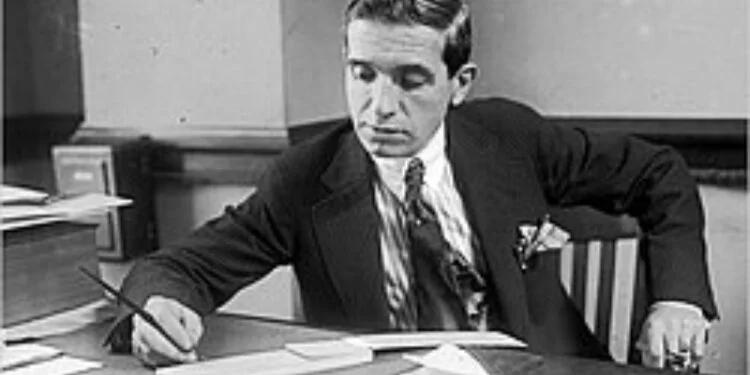
Charles Ponzi: The original architect behind CBEX fraud
Charles Ponzi, unarguably the precursor of CBEX, was down on his luck. In 1919, the Italian immigrant had spent a decade and a half in the US. He was looking for a way to get rich and tried his hand at everything — including bookkeeping, sign painting, grocery clerk, dishwasher, and librarian.
Ponzi caught a lucky break in August 1919, when he received a letter from Europe. In the envelope was an International Reply Coupon (IRC), a clever way to prepay for international postage.
Charles Ponzi realised he might be able to use these coupons to make his fortune. All he needed was investors.
What happened next made him a household name. This is the story of the man behind the eponymous Ponzi scheme — a tale of financial fraud that lives up to its linguistic legacy.
Who Is Charles Ponzi?
Charles Ponzi was an Italian-born swindler whose name is now synonymous with a specific kind of financial fraud known as a Ponzi scheme.
Named Carlo Pietro Giovanni Guglielmo Tebaldo Ponzi, Charles was born on 3 March, 1882 in Lugo, Italy. He died in Rio de Janeiro, Brazil on 18 January, 1949.
Known for creating one of the most famous financial scams in history, Charles Ponzi migrated to the United States of America (USA) and arrived in Boston in 1903, with just $2.50.
The Ponzi Scheme
The fraud by Charles Ponzi revolved around a legitimate concept, International Reply Coupons (IRCs). These were postal coupons that could be exchanged in one country for postage in another.
Because of currency fluctuations, post-World War I, Charles Ponzi realised he could buy IRCs cheaply in Europe and redeem them in the US for more valuable postage.
However, instead of building a legitimate business, Charles Ponzi promised 50 per cent returns in 45 days or 100 per cent in 90 days to investors. Rather than investing the money in IRCs, he used money from new investors to pay earlier ones—a classic pyramid-like scam.
At his peak in 1920, Charles Ponzi was making up to $250,000 a day and lived lavishly, which boosted public confidence in his operation.
Exposure and fall
The name Charles Ponzi immediately brings to mind the financial scheme that bears his name. But what of the man who helped expose the Ponzi scheme?
The unraveling that finally led to the eventual fall of Charles Ponzi began with a journalistic investigation. The Boston Post launched an inquiry, which exposed flaws in his business model.
Simon Swig, it was, who upended Boston’s financial and banking world in the early 20th Century before crossing paths with the notorious scammer, Charles Ponzi
There arose wide bank suspicions when the Hanover Trust Bank (which Ponzi had secretly taken over) faced scrutiny. These suspicions led to legal scrutiny as authorities realised that Charles Ponzi had no real investment to support the huge payouts.
Crucial findings revealed that Charles Ponzi only bought about $30 worth of IRCs, despite receiving millions of dollars from thousands of investors. The scale of the fraud became obvious as he was in debt of about $7 million, which he could never repay.
In the aftermath of the investigations and findings, Ponzi was arrested in August 1920. In two federal indictments, he was charged with 86 counts of mail fraud and faced life imprisonment.
At the urging of his wife, Charles Ponzi pleaded guilty on 1 November, 1920, to a single count charge before Judge Clarence Hale. The judge declared before sentencing: “Here was a man with all the duties of seeking large money. He concocted a scheme which, on his counsel’s admission, did defraud men and women. It will not do to have the world understand that such a scheme as that can be carried out … without receiving substantial punishment.” Ponzi was sentenced to five years in federal prison.
Ponzi was released after three-and-a-half years and was almost immediately indicted on 22 state charges of larceny at Massachusetts which came as a surprise to him.
He sued, claiming that he would be facing double jeopardy, if Massachusetts retried him for the same offenses spelled out in the federal indictment. The case, Ponzi v. Fessenden, made it all the way to the US Supreme Court.
On 27 March, 1922, the Supreme Court ruled that federal plea bargains have no standing regarding state charges. It also ruled that Charles Ponzi was not facing double jeopardy because Massachusetts was charging him with larceny, while the federal government charged him with mail fraud, even though the charges implicated the same criminal operation.
In October 1922, Ponzi was tried on the first 10 larceny counts. Since he was insolvent, Ponzi served as his own attorney and, speaking as persuasively as he had with his duped investors, was acquitted by the jury on all charges. He was tried a second time on five of the remaining charges, and the jury deadlocked. Ponzi was found guilty at a third trial, and was sentenced to an additional seven to nine years in prison as “a common and notorious thief.”
In September 1925, Ponzi was released on bail as he appealed the state conviction. He fled to the Springfield neighborhood of Jacksonville, Florida, and launched the Charpon Land Syndicate (“Charpon” is an amalgamation of his name), seeking to capitalise on the Florida land boom.
Charles Ponzi offered investors tiny tracts of land, some underwater, and promised 200 per cent returns in 60 days. In reality, it was a scam that sold swampland in Columbia County.
Ponzi was indicted by a Duval County grand jury in February 1926 and charged with violating Florida trust and securities laws. A jury found him guilty on the securities charges, and the judge sentenced him to a year in the Florida State Prison. He appealed his conviction and was freed after posting a $1,500 bond.
Charles Ponzi traveled to Tampa where he shaved his head, grew a mustache, and tried to flee the country as a crewman on a merchant ship bound for Italy. However, he revealed his identity to a shipmate. Word spread to a deputy sheriff, who followed the ship to its last American port of call in New Orleans and placed Ponzi under arrest.
Charles Ponzi was sent back to Massachusetts to serve out his prison term. He served seven more years in prison.
In the meantime, government investigators tried to trace the convoluted accounts of Ponzi to figure out how much money he had taken and where it had gone. They never managed to untangle it and could only conclude that millions of dollars had gone through his hands.
Charles Ponzi was released in 1934. With the release came an immediate order to have him deported to Italy. He asked for a full pardon from Massachusetts Governor Joseph B. Ely. However, on July 13, the governor turned down the appeal.
The charismatic confidence of Charles Ponzi had faded, and when he left the prison gates, he was met by an angry crowd. He told reporters before he left: “I went looking for trouble, and I found it.” On October 7, he was officially deported to Italy.
In Italy, Ponzi jumped from scheme to scheme, but little came of them. He eventually got a job in Brazil as an agent for Ala Littoria, the Italian state airline.
His death
Ponzi spent the last years of his life in poverty, working occasionally as a translator. His health deteriorated and, in 1941, he had a heart attack which left him considerably weakened. His eyesight began to fail and, by 1948, he was almost completely blind. A brain hemorrhage paralysed his left leg and arm.
Charles Ponzi died in a charity hospital in Rio de Janeiro, the Hospital São Francisco de Assis of Federal University of Rio de Janeiro, on January 18, 1949.
Supported by his last and only friend, Francisco Nonato Nunes, a barber who spoke English and had notions of Italian, Charles Ponzi in his last interview with an American reporter, said: “Even if they never got anything for it, it was cheap at that price. Without malice aforethought, I had given them the best show that was ever staged in their territory since the landing of the Pilgrims! It was easily worth fifteen million bucks to watch me put the thing over.”
Hope rises for CBEX investors as EFCC promises refund
EFCC alerts Nigerians of 58 Ponzi scheme operators
JUST-IN: Court declares Obasa’s sack illegal
Share your story or advertise with us: Whatsapp: +2348033202396 Email: sentinelnewsng@gmail.com










